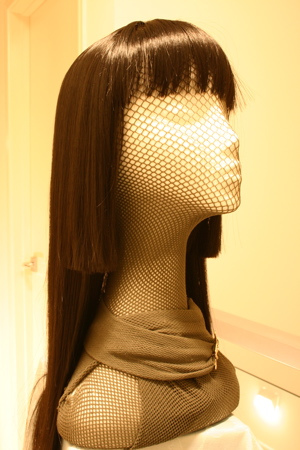Wig
Wig is a head covering made from human hair, animal hair, or synthetic fiber. The term can apply to the garment worn for various reasons, including cultural tradition, costume, disguise, and fashion, as well as to cover partial or total baldness or for therapeutic purposes. Wigs have been used since ancient times across various civilizations for personal adornment, to signify social status, as part of theatrical costumes, and for other purposes.
History[edit | edit source]
The use of wigs dates back to the Ancient Egyptian civilization, where they were worn by the wealthy to protect their shaved, hairless heads from the sun. Wigs were also part of the attire of ancient Greek, Roman, and Phoenician societies, among others. In Europe, wigs gained prominence in the 16th century, reaching their peak in the 17th and 18th centuries. The periwig or peruke was a status symbol among the European aristocracy and judiciary. In the 19th century, the popularity of wigs began to decline, but they remained an essential part of certain professional uniforms, such as those of judges and barristers in some jurisdictions.
Types[edit | edit source]
Wigs come in various styles, including full wigs, hairpieces, and extensions. They can be made to fit the general population or custom-made for a more natural and comfortable fit. The construction of a wig involves the arrangement of hair on a base made of net or other material, which is then fitted to the head.
Materials[edit | edit source]
- Human Hair: Offers the most natural look and feel, and can be styled as desired. However, it requires more maintenance and is generally more expensive.
- Animal Hair: Often used for more traditional or historical wigs. Horse, goat, and yak hair are common.
- Synthetic Fiber: Less expensive and easier to maintain than human hair wigs. Modern synthetic wigs can be very realistic but are less versatile in styling.
Cultural and Social Significance[edit | edit source]
Wigs hold various cultural and social significances. In some cultures, they are worn as part of traditional ceremonies or for religious reasons. For example, some Jewish women wear wigs for modesty. In the realm of fashion and beauty, wigs allow for versatility and changes in appearance without altering one's natural hair. They also play a crucial role in the entertainment industry, enabling actors to transform their appearance for different roles.
Therapeutic Use[edit | edit source]
Wigs are often used by individuals experiencing hair loss due to alopecia, chemotherapy, or other medical conditions. They can provide a sense of normalcy and confidence during difficult times.
Care and Maintenance[edit | edit source]
The lifespan of a wig depends on its material and how well it is cared for. Human hair wigs require similar care to natural hair, including regular washing, conditioning, and styling. Synthetic wigs may need less maintenance but have specific care requirements to maintain their shape and texture.
Legal and Ethical Considerations[edit | edit source]
The wig industry faces legal and ethical considerations, particularly concerning the sourcing of human hair. Ethical sourcing practices are crucial to ensuring that the hair used in wigs is obtained in a manner that respects the rights and dignity of individuals.
Search WikiMD
Ad.Tired of being Overweight? Try W8MD's NYC physician weight loss.
Semaglutide (Ozempic / Wegovy and Tirzepatide (Mounjaro / Zepbound) available. Call 718 946 5500.
Advertise on WikiMD
|
WikiMD's Wellness Encyclopedia |
| Let Food Be Thy Medicine Medicine Thy Food - Hippocrates |
Translate this page: - East Asian
中文,
日本,
한국어,
South Asian
हिन्दी,
தமிழ்,
తెలుగు,
Urdu,
ಕನ್ನಡ,
Southeast Asian
Indonesian,
Vietnamese,
Thai,
မြန်မာဘာသာ,
বাংলা
European
español,
Deutsch,
français,
Greek,
português do Brasil,
polski,
română,
русский,
Nederlands,
norsk,
svenska,
suomi,
Italian
Middle Eastern & African
عربى,
Turkish,
Persian,
Hebrew,
Afrikaans,
isiZulu,
Kiswahili,
Other
Bulgarian,
Hungarian,
Czech,
Swedish,
മലയാളം,
मराठी,
ਪੰਜਾਬੀ,
ગુજરાતી,
Portuguese,
Ukrainian
Medical Disclaimer: WikiMD is not a substitute for professional medical advice. The information on WikiMD is provided as an information resource only, may be incorrect, outdated or misleading, and is not to be used or relied on for any diagnostic or treatment purposes. Please consult your health care provider before making any healthcare decisions or for guidance about a specific medical condition. WikiMD expressly disclaims responsibility, and shall have no liability, for any damages, loss, injury, or liability whatsoever suffered as a result of your reliance on the information contained in this site. By visiting this site you agree to the foregoing terms and conditions, which may from time to time be changed or supplemented by WikiMD. If you do not agree to the foregoing terms and conditions, you should not enter or use this site. See full disclaimer.
Credits:Most images are courtesy of Wikimedia commons, and templates, categories Wikipedia, licensed under CC BY SA or similar.
Contributors: Prab R. Tumpati, MD





